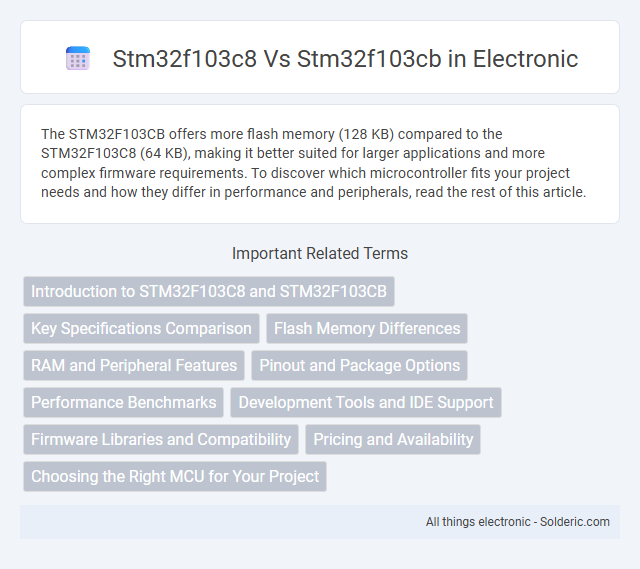The STM32F103CB offers more flash memory (128 KB) compared to the STM32F103C8 (64 KB), making it better suited for larger applications and more complex firmware requirements. To discover which microcontroller fits your project needs and how they differ in performance and peripherals, read the rest of this article.
Comparison Table
| Feature | STM32F103C8 | STM32F103CB |
|---|---|---|
| Core | ARM Cortex-M3, 72 MHz | ARM Cortex-M3, 72 MHz |
| Flash Memory | 64 KB | 128 KB |
| SRAM | 20 KB | 20 KB |
| Package | LQFP-48 | LQFP-48 |
| Max Operating Voltage | 2.0 V to 3.6 V | 2.0 V to 3.6 V |
| Max Operating Temperature | -40degC to 85degC | -40degC to 85degC |
| Peripherals | 3x USART, 2x SPI, 2x I2C, 3x Timers | 3x USART, 2x SPI, 2x I2C, 3x Timers |
| ADC Channels | 10 | 10 |
| DAC | No | No |
| Price Range | Lower (due to less flash) | Higher (more flash) |
Introduction to STM32F103C8 and STM32F103CB
STM32F103C8 and STM32F103CB are microcontrollers from the STM32F1 series by STMicroelectronics, based on the ARM Cortex-M3 core operating at 72 MHz. Both variants feature 64 KB (C8) and 128 KB (CB) of Flash memory, respectively, which impacts application size and complexity capabilities. The STM32F103CB provides increased Flash storage for more extensive firmware, making it suitable for advanced embedded applications requiring additional program space.
Key Specifications Comparison
The STM32F103C8 and STM32F103CB microcontrollers both belong to the STM32F1 series, featuring an ARM Cortex-M3 core running at up to 72 MHz. The STM32F103C8 offers 64 KB of Flash memory and 20 KB of SRAM, while the STM32F103CB provides a larger 128 KB Flash and 24 KB SRAM, making it preferable for more memory-intensive applications. Both support multiple communication interfaces such as USART, SPI, and I2C, but the increased memory in the STM32F103CB can enhance Your project's performance and complexity handling.
Flash Memory Differences
The STM32F103C8 features 64KB of Flash memory, while the STM32F103CB offers a larger 128KB Flash memory capacity, providing double the storage for your firmware and applications. This increased Flash size in the STM32F103CB enables more complex code, additional features, and extended program storage without needing external memory. Selecting the right variant depends on your project's memory demands, with the STM32F103CB preferable for applications requiring higher code density and storage flexibility.
RAM and Peripheral Features
The STM32F103CB offers 128 KB of RAM, which is double the 64 KB RAM available in the STM32F103C8, enhancing its ability to handle more complex applications and larger data stacks. Peripheral features are largely similar between the two, including multiple USART, SPI, I2C interfaces, ADCs, timers, and a CAN interface, but the STM32F103CB supports additional GPIO pins due to its larger package size. This extended pin availability on the STM32F103CB allows greater flexibility for peripheral connections in embedded system designs.
Pinout and Package Options
The STM32F103C8 and STM32F103CB both share the same 48-pin LQFP package, maintaining identical pinout configurations ideal for seamless MCU replacement in existing designs. The primary difference in package options is that STM32F103CB variants may also be available in alternative packages like UFQFPN, expanding integration flexibility. Pin mapping for peripherals, GPIOs, and communication interfaces remains consistent, ensuring software compatibility between the two models.
Performance Benchmarks
The STM32F103C8 and STM32F103CB microcontrollers both feature an ARM Cortex-M3 core running at up to 72 MHz, delivering comparable processing capabilities for real-time applications. Performance benchmarks highlight that the STM32F103CB offers increased flash memory (128 KB vs. 64 KB in the C8), enabling larger and more complex firmware without sacrificing speed or efficiency. Both variants maintain similar RAM sizes and peripheral sets, ensuring consistent execution speed across common embedded system tasks.
Development Tools and IDE Support
STM32F103C8 and STM32F103CB microcontrollers both enjoy extensive development tool compatibility, widely supported by IDEs such as STM32CubeIDE, Keil MDK, and IAR Embedded Workbench. The STM32CubeMX software provides configuration and code generation tailored to each variant's memory size, with STM32F103CB offering larger flash memory benefiting more complex applications. Debugging and programming tools, including ST-Link and J-Link, fully support both models, ensuring streamlined firmware development and deployment across diverse projects.
Firmware Libraries and Compatibility
The STM32F103C8 and STM32F103CB both belong to the STM32F1 series, sharing compatibility with the STM32 Standard Peripheral Libraries and the STM32Cube firmware package, ensuring broad software support. Firmware libraries developed for the STM32F103C8 typically run seamlessly on the STM32F103CB due to their similar architecture and peripheral sets, with the CB variant offering larger flash memory and SRAM capacity. Developers benefit from the seamless API and middleware compatibility across these models, facilitating code portability and minimizing redevelopment effort.
Pricing and Availability
The STM32F103C8 is generally more affordable and widely available in the market due to its longer production history and higher demand, making it a cost-effective choice for budget-conscious projects. In contrast, the STM32F103CB offers slightly expanded memory and features at a higher price point, which may affect its availability in smaller quantities but benefits applications requiring increased performance. Your decision between the two should consider both immediate budget constraints and future scalability needs.
Choosing the Right MCU for Your Project
The STM32F103C8 and STM32F103CB microcontrollers from STMicroelectronics differ primarily in memory size, with the C8 variant offering 64 KB of flash and the CB variant providing 128 KB, which can impact your project's code complexity and feature requirements. Both MCUs share the same 72 MHz ARM Cortex-M3 core, 20 KB of SRAM, and numerous peripherals, making them suitable for a wide range of embedded applications. Selecting the right MCU involves assessing your program memory needs, peripheral usage, and future scalability to ensure efficient performance and cost-effectiveness.
stm32f103c8 vs stm32f103cb Infographic

 solderic.com
solderic.com